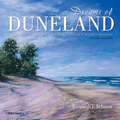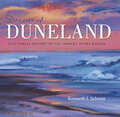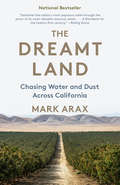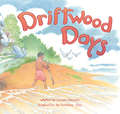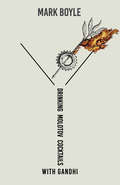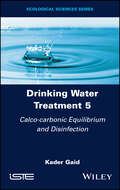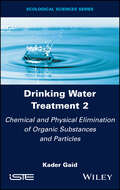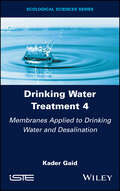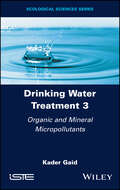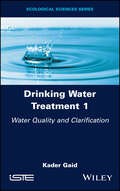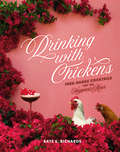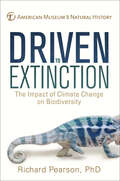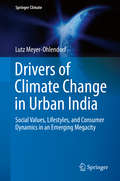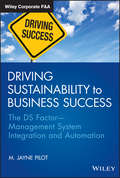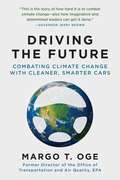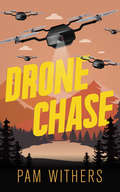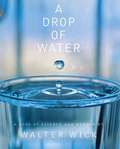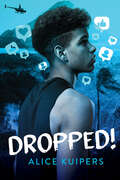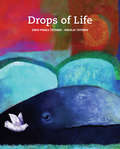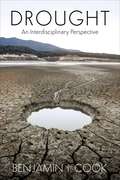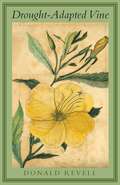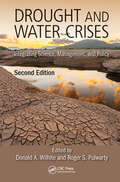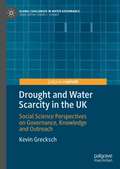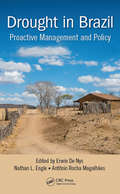- Table View
- List View
Dreams of Duneland: A Pictorial History of the Indiana Dunes Region
by Kenneth J. SchoonThe towering sand dunes along Lake Michigan, not far from Chicago, are one of the most unexpected natural features of Indiana.The second edition of Dreams of Duneland beautifully illustrates the dunes region, from the past to the present. Since the first edition, the Indiana Dunes area has become an official national park. With more than 400 stunning images, many of them new, Dreams of Duneland showcases the breathtaking sand dunes, as well as the rest of this newly minted park, which includes savanna, wetland, prairie, and forest and is home to a wide variety of plant and animal species. Kenneth J. Schoon reveals how the preserved area of the Indiana Dunes National Park—which sits by residential communities, businesses, and cultural attractions—has a long history of competition among farmers, fur traders, industrialists, and conservationists. Featuring a new foreword and afterword and many updates throughout, this gorgeous new edition will have you planning a trip to the extraordinary Indiana Dunes.
Dreams of Duneland: A Pictorial History of the Indiana Dunes Region
by Kenneth J. SchoonThe towering sand dunes along Lake Michigan not far from Chicago are one of the most unexpected natural features of Indiana. Dreams of Duneland is a beautifully illustrated introduction to the Dunes region, its history, and future prospects. This area of shifting sands is also a place of savanna, wetland, prairie, and forest that is home to a wide diversity of plant and animal species. The preserved area of the Indiana Dunes National Lakeshore sits by residential communities, businesses, and cultural attractions, evidence of a long history of competition for the land among farmers, fur traders, industrialists, conservationists, and urban and recreational planners. With more than 400 stunning images, the book brings to life the remarkable story of this extraordinary place.
The Dreamt Land: Chasing Water and Dust Across California
by Mark AraxA vivid, searching journey into California's capture of water and soil--an epic story of a people's defiance of nature and the wonders, and ruin, it has wrought"A stunning history of power, arrogance, and greed."--Kirkus Reviews (starred)Mark Arax is from a family of Central Valley farmers, a writer with deep ties to the land who has watched the battles over water intensify even as California lurches from drought to flood and back again. In The Dreamt Land, he travels the state to explore the one-of-a-kind distribution system, built in the 1940s, '50s and '60s, that is straining to keep up with California's relentless growth.This is a heartfelt, beautifully written book about the land and the people who have worked it--from gold miners to wheat ranchers to small fruit farmers and today's Big Ag. Since the beginning, Californians have redirected rivers, drilled ever-deeper wells and built higher dams, pushing the water supply past its limit.The Dreamt Land weaves reportage, history and memoir to confront the "Golden State" myth in riveting fashion. No other chronicler of the West has so deeply delved into the empires of agriculture that drink so much of the water. The nation's biggest farmers--the nut king, grape king and citrus queen--tell their story here for the first time.This is a tale of politics and hubris in the arid West, of imported workers left behind in the sun and the fatigued earth that is made to give more even while it keeps sinking. But when drought turns to flood once again, all is forgotten as the farmers plant more nuts and the developers build more houses.Arax, the native son, is persistent and tough as he treks from desert to delta, mountain to valley. What he finds is hard earned, awe-inspiring, tragic and revelatory. In the end, his compassion for the land becomes an elegy to the dream that created California and now threatens to undo it.
Driftwood Days
by William MiniverUnder autumn leaves, a boy watches a beaver build a dam. One of the branches slips away, carried downstream by the river. Through the changing seasons, the branch makes a long, epic journey to the sea, before finally getting tossed back onto shore. Changed by the elements, the branch—now driftwood—lies patiently on the beach, until the boy discovers it once again.Featuring breathtaking artwork by Charles Vess, Driftwood Days offers readers a beautiful, multilayered story about nature, science, childhood, and change.
Drinking Molotov Cocktails with Gandhi
by Mark BoyleMore than ever, people are longing for deep and meaningful change. Another world is not only possible; it is essential. Yet despite our creative and determined efforts to attain social justice and ecological sustainability, our global crises continue to deepen.In Drinking Molotov Cocktails with Gandhi, best-selling author Mark Boyle argues that our political and economic system has brought us to the brink of climate catastrophe, ransacking ecosystems and unraveling communities for the benefit of the few at the expense of the many. He makes a compelling case that we must "rewild" the political landscape, as history teaches us that positive social change has always been wrought by movements prepared to use any means available.The time has come for pacifists, revolutionaries, and freedom fighters to work together for the creation of a world worth sustaining. Eloquent, visionary, and beautifully written, this incendiary manifesto strikes at the heart of the world's crises and reframes our understanding of how to solve them, signaling a turning point in our journey towards an ecologically just society.The three R's of the climate change generation--reduce, reuse, and recycle--are long overdue for an upgrade .Welcome to resist, revolt, rewild.Mark Boyle is the author of The Moneyless Man and The Moneyless Manifesto. He lived completely without money for three years, and is a director of the global sharing community streetbank.com.
Drinking Water Treatment, Calco-carbonic Equilibrium and Disinfection
by Kader GaidToday, hundreds of millions of people drink contaminated water without knowing it. Yet water treatment technologies can effectively eliminate contamination and can supply urban and rural populations with safe drinking water in a secure way. For almost two centuries, the huge number of treatments available to guarantee water quality has grown alongside technological progress, the strengthening of industry norms and the reinforcement of consumer expectations. New treatment methods have been developed according to the advancement of knowledge and new sanitary regulations. This five-volume book sets out to clearly present the variety of treatments available along with their performance, limitations and conditions of use as well as ways to combine them to produce safe drinking water, which is a basic need essential to everyday life. The author shares his expertise acquired at Veolia, a company that is a world leader in water services and sanitation, desalination of sea water and the recycling of wastewater. Founded in France in 1853 to bring safe water to populations and to protect them from waterborne epidemics which ravaged cities, its history is intertwined with that of water treatment.
Drinking Water Treatment, Chemical and Physical Elimination of Organic Substances and Particles
by Kader GaidToday, hundreds of millions of people drink contaminated water without knowing it. Yet water treatment technologies can effectively eliminate contamination and can supply urban and rural populations with safe drinking water in a secure way.For almost two centuries, the huge number of treatments available to guarantee water quality has grown alongside technological progress, the strengthening of industry norms and the reinforcement of consumer expectations. New treatment methods have been developed according to the advancement of knowledge and new sanitary regulations.This five-volume book sets out to clearly present the variety of treatments available along with their performance, limitations and conditions of use as well as ways to combine them to produce safe drinking water, which is a basic need essential to everyday life.The author shares his expertise acquired at Veolia, a company that is a world leader in water services and sanitation, desalination of sea water and the recycling of wastewater. Founded in France in 1853 to bring safe water to populations and to protect them from waterborne epidemics which ravaged cities, its history is intertwined with that of water treatment.
Drinking Water Treatment, Membranes Applied to Drinking Water and Desalination
by Kader GaidToday, hundreds of millions of people drink contaminated water without knowing it. Yet water treatment technologies can effectively eliminate contamination and can supply urban and rural populations with safe drinking water in a secure way. For almost two centuries, the huge number of treatments available to guarantee water quality has grown alongside technological progress, the strengthening of industry norms and the reinforcement of consumer expectations. New treatment methods have been developed according to the advancement of knowledge and new sanitary regulations. This five-volume book sets out to clearly present the variety of treatments available along with their performance, limitations and conditions of use as well as ways to combine them to produce safe drinking water, which is a basic need essential to everyday life. The author shares his expertise acquired at Veolia, a company that is a world leader in water services and sanitation, desalination of sea water and the recycling of wastewater. Founded in France in 1853 to bring safe water to populations and to protect them from waterborne epidemics which ravaged cities, its history is intertwined with that of water treatment.
Drinking Water Treatment, Organic and Mineral Micropollutants
by Kader GaidToday, hundreds of millions of people drink contaminated water without knowing it. Yet water treatment technologies can effectively eliminate contamination and can supply urban and rural populations with safe drinking water in a secure way. For almost two centuries, the huge number of treatments available to guarantee water quality has grown alongside technological progress, the strengthening of industry norms and the reinforcement of consumer expectations. New treatment methods have been developed according to the advancement of knowledge and new sanitary regulations. This five-volume book sets out to clearly present the variety of treatments available along with their performance, limitations and conditions of use as well as ways to combine them to produce safe drinking water, which is a basic need essential to everyday life. The author shares his expertise acquired at Veolia, a company that is a world leader in water services and sanitation, desalination of sea water and the recycling of wastewater. Founded in France in 1853 to bring safe water to populations and to protect them from waterborne epidemics which ravaged cities, its history is intertwined with that of water treatment.
Drinking Water Treatment, Water Quality and Clarification
by Kader GaidToday, hundreds of millions of people drink contaminated water without knowing it. Yet water treatment technologies can effectively eliminate contamination and can supply urban and rural populations with safe drinking water in a secure way. For almost two centuries, the huge number of treatments available to guarantee water quality has grown alongside technological progress, the strengthening of industry norms and the reinforcement of consumer expectations. New treatment methods have been developed according to the advancement of knowledge and new sanitary regulations. This five-volume book sets out to clearly present the variety of treatments available along with their performance, limitations and conditions of use as well as ways to combine them to produce safe drinking water, which is a basic need essential to everyday life. The author shares his expertise acquired at Veolia, a company that is a world leader in water services and sanitation, desalination of sea water and the recycling of wastewater. Founded in France in 1853 to bring safe water to populations and to protect them from waterborne epidemics which ravaged cities, its history is intertwined with that of water treatment.
Drinking with Chickens: Free-Range Cocktails for the Happiest Hour
by Kate E. RichardsIt's drinks, it's chickens: It's the cocktail book you didn't know you needed!To add some extra happy to your happy hour , invite a chicken and pour yourself a drink. Author Kate Richards serves up cocktails made for Instagram with the spoils of her Southern California garden, chicken friends by her side. Enjoy any (or all) of the 60+ deliciously drinkable garden-to-glass beverages, such as:Lilac Apricot Rum Sour Meyer Lemon + Rosemary Old Fashioned Rhubarb Rose Cobbler Blackberry Sage Spritz Cantaloupe Mint Rum PunchCocktails are arranged seasonally, and are 100% accessible for those of us without perpetually sunny backyard gardens at our disposal. Drinking with Chickens will quickly become a boozy favorite, perfect for gifting or for hoarding all for yourself. You don't need chickens to enjoy these drinks or the colorful photos, but be careful, because you may even find yourself aspiring to be, as Kate is, a home chixologist overrun by gorgeous, loud, early-rising egg-laying ladies, and in need of a very strong drink.
Driven by Demand: How Energy Gets its Power
by Jimmy Y. Jia Jason CrabtreeEnergy plays a central role in shaping our society and infrastructure, making it increasingly important for today's leaders to understand the impact of energy decisions. Discussions about energy often neglect important historical lessons about previous energy transformations and provide inadequate consideration of context - Driven by Demand takes a fresh approach by exploring the emergence of energy systems, outcomes and priorities. It outlines select historical and current events, challenges, and developing energy trends using a range of case studies. Readers will gain foundational knowledge about energy flows and end-uses, helping them to become more conversant about energy outcomes and priorities. This accessible book paves the way for broader discussions about societal resilience, privacy, and security concerns associated with the move towards 'smart' infrastructure. This is a must-read for business executives, policymakers and students working in energy policy, energy management and sustainable business.
Driven to Extinction: The Impact of Climate Change on Biodiversity
by Richard Pearson“A primer on one of the most contentious topics in modern ecology . . . an effective counter to misinformation elsewhere.” —Frontiers of BiogeographyCould more than a million species disappear in the twenty-first century?Written by a leading scientist in the field, Driven to Extinction draws upon fascinating case studies from around the world, providing balanced and well-reasoned insight into the potential impacts of climate change on the diversity of life. Richard Pearson focuses on the science of the issue, revealing what has happened––as well as what is likely to happen––to some of the world’s weirdest and most wonderful species as global temperatures continue to rise.“A nuanced and fascinating book about the interrelationship of two of the greatest challenges humanity will face in this century—holding climate change within manageable bounds and preserving biodiversity in the face of rapidly changing habitat and a changing climate.” —John Topping, President of the Climate Institute“The ideal resource for citizens concerned about the dangers of climate change and the future of biodiversity.” —Spirituality & Practice“A carefully crafted and highly readable analysis . . . devoid of jargon and excessive technical terminology, Pearson’s work is highly recommended to anyone with interest in nature conservation or broader climate change issues.” —Biological Conservation“A wonderfully written revelation of how nature is stirring in response to climate change—and a wake-up call to what could happen to our fellow inhabitants on the living planet. Required reading for every citizen.” —Thomas E. Lovejoy, Biodiversity Chair, the Heinz Center, and Senior Advisor to the United Nations Foundation
Drivers of Climate Change in Urban India: Social Values, Lifestyles, and Consumer Dynamics in an Emerging Megacity (Springer Climate)
by Lutz Meyer-OhlendorfThis study transcends the homogenizing (inter-)national level of argumentation (‘rich’ versus ‘poor’ countries), and instead looks at a sub-national level in two respects: (1) geographically it focuses on the rapidly growing megacity of Hyderabad; (2) in socio-economic terms the urban population is disaggregated by taking a lifestyle typology approach. For the first time, the lifestyle concept – traditionally being used in affluent consumer societies – is applied to a dynamically transforming and socially heterogeneous urban society. Methodically, the author includes India-specific value orientations as well as social practices as markers of social structural differentiation. The study identifies differentials of lifestyle-induced GHG emissions (carbon footprints) and underlines the ambiguity of a purely income based differentiation with regard to the levels of contribution to the climate problem.
Driving Sustainability to Business Success
by M. Jayne PilotEfficient, compliant management systems pave the road to sustainability through integration and automationThe book addresses the many definitions of sustainability and why CEOs need the links between sustainability, business value, and performance. Business leaders are committed to leading the way, and the book outlines the support of a management system structure and business principles that will drive the accomplishment of their mission. Stakeholder demands on CEOs include many challenges. Investors are assessing companies for financial performance. The shrinking talent pool of employees is looking to work with organizations that support social, environment, and economic operating practices and principles.Great leaders are those that ask questions, who are creative to drive innovation for growth of their company. The Assess-Reflect-Act section on international business principles defined in the book will ask you as the leader thought provoking questions to stimulate action within your organization to bring people, processes, and technology together for business success.Leaders need to transition to smart decisions that are data driven. The company's management system structure is important to build a strong framework for business process operations and automation for global competitiveness. Topics include:Business plans vs management systemsManagement system frameworks: standardization, ISO standards: Quality -- ISO 9001, Environment -- ISO 14001, OHSAS 18001, Integrated Management SystemsThree Steps for Process Development: Identify, Insure, ImproveFocus for the Organization: Compliance Costs, Best Practices, Strategic PlanningSupport -- Resources: Innovation, Engagement, Succession PlanningData as a Valuable ResourceOperation: Process Risks, Management System Control Plan, E-commerce, Enterprise Resource Planning (ERP), Green Awareness-Eco Design, Automated Controls, Cloud ComputingPerformance Evaluation -- Monitor, Measure, Analyze, Audit, Management ReviewCompetitive LandscapeThe constant need to improve internal processes and move toward business sustainability and quality standards is a major stressor for governments and businesses. With one-third of the workforce retiring in the next five to ten years, the need has become more immediate, and the focus has shifted to building a strong framework for business process operations and automation for global competitiveness. This book provides a roadmap to efficient, compliant systems, showing businesses how to build toward sustainability goals and capture key knowledge of the employees involved in the process.
Driving the Future: Combating Climate Change with Cleaner, Smarter Cars
by Margo T Oge Fred KruppNow in paperback, with a new foreword by Fred Krupp, an expert's illuminating preview of the cleaner, lighter, smarter cars of the future.In Driving the Future, Margo T. Oge portrays a future where clean, intelligent vehicles with lighter frames and alternative power trains will produce zero emissions and run at 100+ mpg. With electronic architectures more like those of airplanes, cars will be smarter and safer, will park themselves, and will network with other vehicles on the road to drive themselves. As the director of the EPA’s Office of Transportation and Air Quality, Oge was the chief architect behind the Obama administration’s landmark 2012 deal with automakers in the US market to double the fuel efficiency of their fleets and to cut greenhouse gas emissions in half by 2025. This was America’s first formal climate action using regulation to reduce emissions through innovation in car design.Offering an insider account of the partnership between federal agencies, California, environmental groups, and car manufacturers that led to the historic deal, Margo discusses the science of climate change, the politics of addressing it, and the lessons learned for policy makers. She also takes the reader through the convergence of macro trends that will drive this innovation over the next forty years and be every bit as transformative as those wrought by Karl Benz and Henry Ford. Driving the Future is for anyone who wants to know what car they’ll be driving in ten, twenty, or thirty years-and for everyone concerned about air quality and climate change now.
Drone Chase
by Pam WithersRay will need every ounce of his drone skills and outdoor smarts to recover his missing bear cub before poachers get to it first.When his orphan bear cub goes missing, sixteen-year-old drone enthusiast Ray McLellan decides to use his airborne spying skills to find it. Little does he know that an evil bear-poaching gang operating in the surrounding forest has drones, too — and a cold welcome for those who would attempt to take them down.As a New York City kid recently forced to move to the Great Bear Rainforest by his parents, Ray doesn’t have a lifetime of outdoor instincts or familiarity with the valley and its wildlife. That makes him very different from his grumpy grandfather, who — like his new school friends — berates his city-kid uselessness at every opportunity. Can Ray use his drones and smarts to prove himself, find his cub, and expose what’s going on in the woods?
A Drop of Water
by Walter Wick<p>The most spectacular photographs ever created on the subject of water appear in this unique science book by Walter Wick. The camera stops the action and magnifies it so that all the amazing states of water can be observed - water as ice, rainbow, stream, frost, dew. Readers can examine a drop of water as it falls from a faucet, see a drop of water as it splashes on a hard surface, count the points of an actual snowflake, and contemplate how drops of water form clouds. <p>[This text is listed as an example that meets Common Core Standards in English language arts in grades 2-3 at http://www.corestandards.org.]
Dropped! (Orca Anchor)
by Alice KuipersDex is dropped onto a deserted tropical island to be a player in a social media competition. Dex is one of six contestants on Dropped!, an internet reality show. He’s glad to escape his real life after being dumped by his girlfriend, Lola, and destroying his social life. He and the other contenders have to spend five days on a deserted island, and the person who gains the most likes and followers will be the winner. The prize is a ton of money and status as an influencer. Keeping people watching is the challenge, and Dex will do whatever it takes. He needs to win—it’s the only way to get Lola and his popularity back. But on the island, away from his ex, he finds himself flirting with the gorgeous and popular Amina. When Dex keeps placing behind Amina, he realizes he has to be more daring to get the engagements he needs. But how extreme will he need to be? And is it worth it to win?
Drops of Life
by Esko-Pekka Tiitinen Nikolai TiitinenAn adaptation of Esko-Pekka Tiitinen's internationally known children's play, the story of endangered species from all over the world coming together to save the planet instills in children the importance of being environmentally conscious. An elderly owl and a whale help a dove make the long journey home to Africa, but once they arrive, they find that a desert has taken over the once-lush forest. With the cooperation of other animals, a human, the sun, the water, and a favorable wind, they can sow the seeds of life again. This beautifully illustrated fable deals with many themes, including solidarity, respect for nature, overcoming obstacles by helping one another, and the benefits of teamwork.
Drought: An Interdisciplinary Perspective
by Ben CookWater is fundamental to all life. From the Dust Bowl of the 1930s, to the extreme water shortages that have struck California in recent years, modern societies often take its abundance for granted until it unexpectedly becomes scarce. Drought is one of the many problems anthropogenic climate change may exacerbate, but it is also a complex phenomenon at the intersection of a range of scientific disciplines and public policy issues. In this innovative book, Benjamin I. Cook brings together climate science, hydrology, and ecology to provide a synthetic overview of drought and its environmental and social consequences.Cook introduces readers to the hydroclimate and its components, explaining the global water cycle, the earth’s climate system, and the distribution of water resources. He discusses drought dynamics and variability over time, the climatological context and ecological effects, and environmental issues such as desertification, land degradation, and groundwater depletion. He also considers the socioeconomic impacts of drought and the role of drought risk management policy, especially in light of how climate change is expected to affect drought risk and severity. Cook gives special attention to paleoclimate and the role of drought in the crises of ancient civilizations. A scientifically comprehensive and approachable overview of water issues throughout the world, Drought is a critical interdisciplinary text that will be essential reading for a broad range of students in earth science and environmental and sustainability studies.
Drought-Adapted Vine
by Donald Revell"Donald Revell writes with a drunken equipoise among the weedy flowers and bees of roadside museums and vacant churches. . . .[Here] are poems that border the hereafter and revive the child's play of prophecy. What miraculous assistance they provide!"--Dean YoungDonald Revell pushes boundaries between words and music, transcending our current notion of beauty and innocence. Personal memory, the visionary, the eccentric, and the divine intertwine between networks of stories that connect past and present through paint strokes, composition, and pastoral lyric. Pure of heart poems lie down in a vibrant field of paradox, basking gratefully in the sun of unknowing.From "Beyond Disappointment":Hence and farewell valediction: "life's journey."It makes no sense. The children mock us with it.A typewriter beneath the Christmas treeCalls to the icecaps. Illustrated monthliesBurn in the wasps' burnt nest. It isSuch perfections make the sun to rise. Donald Revell has authored eleven collections of poetry, most recently Tantivy (2012) and The Bitter Withy (2009). Winner of the PEN USA Translation Award and two-time winner of the PEN USA Award for Poetry, he has also won the Academy of American Poets' Lenore Marshall Prize and is a former Fellow of the Ingram Merrill and Guggenheim Foundations. Additionally, he has twice been awarded fellowships from the National Endowment for the Arts. Former editor-in-chief of Denver Quarterly, he now serves as poetry editor of Colorado Review. Revell is the director of graduate studies and professor of English at the University of Nevada, Las Vegas.
Drought and Water Crises: Integrating Science, Management, and Policy, Second Edition (Drought and Water Crises)
by Donald Wilhite Roger S. PulwartyOver the past decade there have been extraordinary advances towards drought risk reduction with the development of new water-conserving technologies, and new tools for planning, vulnerability and impact assessment, mitigation, and policy. Drought and Water Crises: Integrating Science, Management, and Policy, Second Edition comprehensively captures this evolving progress as it discusses drought management in the light of present risks, global climate change and public policy actions. This new edition emphasizes the paradigm shift from managing disasters to managing risk, reflecting the global emphasis that has evolved in recent years, a new focus that shines light on preparedness strategies and the tools and methods that are essential in drought risk reduction. The book provides additional relevant case studies that integrate this new approach and discusses examples applied in both developed and developing countries.
Drought and Water Scarcity in the UK: Social Science Perspectives on Governance, Knowledge and Outreach (Global Challenges in Water Governance)
by Kevin GreckschThis book presents a social science perspective on drought and water scarcity in the UK. It puts forward a narrative of how different stakeholders manage drought and water scarcity, how they generate and manage knowledge and how power relationships between stakeholders shape drought and water scarcity management. The book begins with an analysis and critique of all water resources management plans produced by English and Welsh water supply companies for the period 2014-2019 and introduces a novel typology for drought management options. It then moves on to discuss the effect of drought and water scarcity on businesses and production processes as well as how knowledge about drought and water scarcity is generated, by whom and for what purpose. Ultimately the book argues for the urgent need to engage people in the UK about water issues and offers a novel perspective on how to communicate and engage with drought research.
Drought in Brazil: Proactive Management and Policy (Drought and Water Crises)
by Erwin De Nys, Nathan L. Engle & Antônio Rocha MagalhãesDrought is a slow-onset natural hazard that is often referred to as a creeping phenomenon. The challenge of monitoring drought’s onset and evolution, and identifying its termination or end is one that scientists, natural resource managers, and decision makers have been struggling with for decades. However, drought management must be aimed at reducing the risks of future drought events on economies, the environment, and the social fabric of regions. As with many countries, droughts are often managed as a crisis in Brazil, rather than events for which officials and communities proactively prepare. Although droughts are not new to Brazil, the recent spate of droughts in the poverty stricken semi-arid Northeast and the industrial hub of São Paulo in the Southeast has forced the country to think more seriously about finally changing its drought policies and management approaches. The book is told through the perspectives of the ministers and secretaries, state policy and technical officials, civil society organizations, and development practitioners that helped to facilitate the shift in paradigm in Brazil from crisis management and towards proactive management of droughts. It is written in a style that is appealing to both technical and non-technical audiences, and aims to provide a framework and lessons for other countries to consider when embarking upon similar efforts to improve their own drought policy and management systems.
